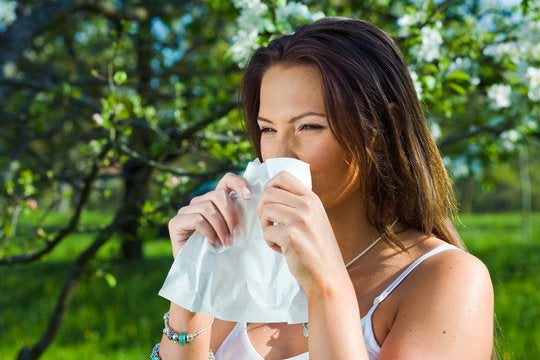Spring welcomes fresh blooming gardens and vibrant greenery – but for many, it also brings sneezing, itchy eyes, and heightened sensitivity to scents. If you suffer from seasonal allergies, you might be someone who tends to avoid perfume altogether come springtime. However, with the right approach and fragrance selection, you can douse yourself in your favorite scents without triggering allergies or making symptoms worse.
Check out our comprehensive guide to navigating how spring allergies affect your fragrance tolerance, which ingredients to avoid, and the best hypoallergenic and allergy-friendly fragrance options for the sensitive season.
How Spring Allergies Affect Fragrance Sensitivity
During allergy season, your body is already in a heightened state of immune response, which can make you more reactive to fragrances in several ways:
-
Lowered tolerance threshold: Your body's histamine response is already activated, making additional triggers more impactful
-
Nasal passage inflammation: Swollen nasal passages can make even mild scents feel overwhelming
-
Cross-sensitization: Some botanical ingredients in perfumes may cross-react with pollen allergens
-
Sensory overload: Your nervous system is already processing irritation signals, making additional stimuli more noticeable
For the approximately 60 million Americans who suffer from seasonal allergies, finding fragrance that doesn't exacerbate symptoms becomes a never-ending struggle.
Fragrance Ingredients That May Worsen Spring Allergies
When selecting fragrances during allergy season, it's helpful to know which common perfume ingredients might intensify your symptoms:
Potentially Problematic Ingredients
-
Heavy florals: Jasmine, lily, gardenia, and rose can mimic outdoor allergens
-
Aldehydes: These synthetic compounds create lift and brightness but can irritate sensitive respiratory tracts
-
Synthetic musks: Particularly galaxolide and tonalide, which may trigger respiratory sensitivity
-
High-alcohol formulations: Can dry and irritate nasal passages already affected by allergies
-
Atranol and chloroatranol: Common in oak moss and tree moss absolutes, these are among the most allergenic fragrance compounds
Better Alternatives for Sensitive Noses
-
Minimalist compositions: Fragrances with fewer ingredients present fewer potential triggers
-
Undenatured alcohol or alcohol-free bases: Less drying and irritating to sensitive tissues
-
Synthetic molecules: Often cleaner and less likely to contain unexpected allergens than natural botanicals
-
Fragrance marketed for sensitive skin: Often formulated without common sensitizers
10 Best Fragrance Types for Spring Allergy Sufferers
1. Clean, Aquatic Scents
Light, water-inspired fragrances typically contain fewer allergens and dissipate gently:
-
Why they work: Usually created with synthetic molecules rather than botanical extracts
-
Notes to look for: Sea salt, water lily, cucumber, light mineral notes
-
Recommended options:
-
Issey Miyake L'Eau d'Issey Pure
-
Jo Malone Wood Sage & Sea Salt
-
Clean Reserve Rain
2. Minimalist, Single-Note Fragrances
These streamlined compositions contain fewer ingredients, reducing allergen exposure:
-
Why they work: Simple construction means fewer potential irritants
-
Notes to look for: Single-note hinoki, lavender, or bergamot scents
-
Recommended options:
-
Escentric Molecules Molecule 01 (contains just one molecule: Iso E Super)
-
Heretic Dirty Hinoki
-
DedCool Fragrance 01 "Taunt"
3. Skin-Scent Musks
Subtle, close-to-skin fragrances with modern synthetic musks are generally well-tolerated:
-
Why they work: Modern musks are designed to be gentle skin adhesives
-
Notes to look for: White musk, ambrette, clean laundry notes
-
Recommended options:
-
Juliette Has a Gun Not a Perfume (contains only Ambroxan)
-
Glossier You
-
Narciso Rodriguez For Her Pure Musc
4. Light Citrus Compositions
Citrus oils generally contain fewer allergens than floral extracts:
-
Why they work: Refreshing without the heavy compounds found in more complex fragrances
-
Notes to look for: Bergamot, yuzu, mandarin, lemon
-
Recommended options:
-
Acqua di Parma Colonia
-
Atelier Cologne Orange Sanguine
-
Jo Malone Lime Basil & Mandarin
5. Transparent Woods
Woody fragrances can be surprisingly gentle, especially those featuring lighter cedar notes:
-
Why they work: Modern woody molecules provide texture without heaviness
-
Notes to look for: Iso E Super, cedar, hinoki, transparent sandalwood
-
Recommended options:
-
Le Labo Santal 33
-
Diptyque Tam Dao
-
Maison Louis Marie No.04 Bois de Balincourt
6. Certified Hypoallergenic Fragrances
Specifically formulated for sensitive individuals, these undergo additional testing:
-
Why they work: Formulated without common allergens and dermatologist tested
-
Notes to look for: Various, but specifically labeled as hypoallergenic
-
Recommended options:
-
By Rosie Jane James
-
PHLUR Hanami
-
Skylar Fragrance Isle
7. Essential Oil-Free Compositions
Some innovative brands create fragrances without traditional essential oils:
-
Why they work: Avoid terpenes and other natural compounds that can trigger reactions
-
Notes to look for: Look for "essential oil-free" labeling
-
Recommended options:
-
Ellis Brooklyn SUPER Amber
-
Henry Rose Queens & Monsters
-
The 7 Virtues Vanilla Woods
8. Alcohol-Free Formulations
Oil-based or water-based alternatives eliminate the potential irritation from alcohol:
-
Why they work: No evaporating alcohol to irritate nasal passages
-
Notes to look for: Various, but in oil, balm, or solid form
-
Recommended options:
-
Kai Perfume Oil
-
Malin+Goetz Cannabis Perfume Oil
-
Le Labo Solid Perfume
9. Subtle Green Scents
Certain green, vegetal notes can be refreshing without mimicking troublesome pollens:
-
Why they work: Evoke spring without heavy florals that might trigger associations with allergens
-
Notes to look for: Vetiver, gentle herbs, green tea
-
Recommended options:
-
Diptyque Vetyverio
-
Jo Malone Blackberry & Bay
-
Aesop Hwyl
10. Light Gourmands
Subtle food-inspired notes rarely trigger seasonal allergy symptoms:
-
Why they work: Food notes engage different scent receptors than those typically irritated during allergy season
-
Notes to look for: Light vanilla, almond, tea, milk
-
Recommended options:
-
Maison Margiela REPLICA Coffee Break
-
Commodity Milk
-
Kayali Vanilla 28
Application Tips for Allergy Season
How you apply fragrance can be just as important as what you apply:
-
Apply to clothing rather than skin: This creates a diffusion barrier and reduces direct inhalation
-
Use half your usual amount: Lighter application means less potential for irritation
-
Spray fragrance at least 30 minutes before going outside: Allows the most volatile (and potentially irritating) top notes to dissipate
-
Consider fragrance-free days during peak pollen periods: Give your senses a break when environmental allergens are highest
-
Test before committing: Sample new fragrances by spraying on a tissue first, then progress to fabric, then skin if well-tolerated
When to Choose Fragrance-Free
Sometimes, the best choice during severe allergy flares is to take a fragrance break:
-
During peak symptom days
-
When visiting environments with poor ventilation
-
If using multiple medicated nasal sprays (which can increase sensitivity)
-
When around others who may have fragrance sensitivities
-
If you develop a headache, sneezing, or increased congestion when wearing fragrance
Understanding Fragrance Allergens vs. Irritants
There's an important distinction between true fragrance allergies and irritant reactions:
-
Allergic reactions involve immune system response and can include rash, hives, or difficulty breathing
-
Irritant reactions are direct responses to chemical compounds and typically include headache, sneezing, or discomfort
Most spring allergy sufferers experience irritant reactions to fragrance rather than true allergies, though both can occur simultaneously.
The Rise of Fragrance-Conscious Brands
The perfume industry is increasingly responding to consumer demand for gentler options:
-
"Clean" fragrance movement: Brands like Henry Rose, By Rosie Jane, and Phlur prioritize transparency and avoid certain sensitizing ingredients
-
Hypoallergenic testing: More companies now conduct specific testing for potential allergens
-
Simpler formulas: A return to perfumery with fewer ingredients and less complex compositions
-
Alternative carriers: Water-based and oil-based options expand choices for those sensitive to alcohol
Reclaim Your Scent Experience
Spring allergies don't have to rob you of your favorite fragrances. With the right knowledge and strategic choices, you can indulge in beautiful scents while keeping your symptoms in check. The key is finding your personal sweet spot – fragrances with cleaner compositions, application techniques that minimize irritation, and brands that prioritize sensitive skin.








